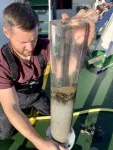(Press-News.org) For the first time, the developmental stages of the deadliest human malaria parasite have been mapped in high resolution, allowing researchers to understand this ever-adapting adversary in more detail than previously possible.
The study, published today (2 May) in Science, details the critical developmental stages of the malaria parasite, Plasmodium falciparum, using single-cell RNA sequencing. This gives detailed information on the life stages of this parasite as it matures, changing from an asexual state to a sexual state, which is necessary before the parasite can be transmitted to mosquitoes.
The research from the Wellcome Sanger Institute, the Malaria Research and Training Center (MRTC) in Mali, and other collaborators, adds to the freely available Malaria Cell Atlas1. The Atlas provides information for researchers worldwide to investigate and generate tools to track the disease.
The novel insights accessible through the Malaria Cell Atlas can also help identify new ways to block the parasite’s development, including through new drugs or vaccines that can prevent transmission.
Malaria is a life-threatening disease with an estimated 249 million cases and 608,000 deaths globally in 20222. It is caused by the Plasmodium parasite, with P. falciparum being the deadliest type of this parasite and the most prevalent on the African continent2.
P. falciparum is a single-celled parasite that evolves quickly, making it difficult to develop long-lasting and effective diagnostics, drugs and vaccines to protect against it. Malaria parasites have a huge amount of genetic diversity and people are frequently infected with multiple different parasite strains. In Mali, around 80 per cent of people infected with malaria carry multiple genetically distinct parasite strains3.
Malaria parasites are found in either an asexual or sexually developed form in the human host. Asexual replication in humans is what causes the symptoms of malaria, but to transmit, parasites have to develop and become either a male or female reproductive cell, known as a gametocyte.
Sexual commitment and development are controlled by transcription factors, which are proteins that regulate gene activity. The mature sexual forms of the parasite circulate in the bloodstream until they are taken up by mosquitoes.
In the latest research, from the Wellcome Sanger Institute and the MRTC in Mali researchers used both long-read and short-read single-cell RNA sequencing to map the sexual development stages of P. falciparum in the laboratory. This allowed them to track the gene expression levels and highlight which genes are involved in each stage of the process.
The team then applied this approach to parasites from blood samples collected from four people naturally infected with malaria in Mali. This is the first time that these technologies have been applied to real-time infection strains at such a high resolution.
By comparing the laboratory data with the natural infection data, the researchers found parasite cell types not previously seen in laboratory strains, highlighting the importance of real-world data.
The team compared different natural P. falciparum strains within each donor to identify genes of interest.
Some of the genes that were overexpressed in particular strains in the sexual development stages are involved in the survival of the parasite in the
ito, including one that plays a role in dampening mosquito immunity. The next step will be to assess the impact these genes have on transmission.
Jesse Rop, co-first author from the Wellcome Sanger Institute, said: “This is the first time that we have been able to map the sexual development stages of malaria parasites in both laboratory and natural strains, allowing us to gain deeper insight into the similarities and differences. Our research uncovered new biology present in the naturally occurring strains that are not seen in laboratory strains, improving our understanding of how malaria develops and spreads.”
Dr Sunil Dogga, co-first author from the Wellcome Sanger Institute, said: “Our research adds to the growing Malaria Cell Atlas, giving a high-quality, open-access genomic resource for researchers worldwide. This high-resolution atlas can be used by scientists to gain a clear understanding of the genes they are investigating, combine research efforts, and help us more effectively prevent, control, and treat malaria. Working together as a scientific community is the only way we are going to successfully control and treat malaria.”
Professor Abdoulaye Djimdé, co-author from the Malaria Research and Training Centre, University of Bamako, Mali, and Honorary Faculty at the Wellcome Sanger Institute, said: “Malaria has a huge global impact, affecting millions of people each year, and attempts to control and treat the disease are quickly overcome by the parasite. Understanding more about the parasite’s life cycle, the genes involved, and the factors that control these, can be vital to ongoing malaria research. Our research highlights key points in the sexual development of the parasite, which if targeted in future drug development could break the cycle of transmission and help minimise the spread.”
Dr Mara Lawniczak, senior author from the Wellcome Sanger Institute, said: “This new focus of the Malaria Cell Atlas project on natural infections coincides with malaria vaccines being used for the first time and a continued rise of drug resistance. Single-cell RNA sequencing gives us a window into parasite gene usage that is not possible with any other approach, while also providing a much clearer understanding of just how genetically diverse parasites are, even within the same person. The Malaria Cell Atlas is a resource we hope will be increasingly useful on the path to malaria elimination.”
ENDS
Contact details:
Rachael Smith
Press Office
Wellcome Sanger Institute
Cambridge, CB10 1SA
Email: press.office@sanger.ac.uk
Notes to Editors:
This research adds to the Malaria Cell Atlas and gives more in-depth insights into the variation of individual malaria parasites, compared to grouping samples together and sequencing in bulk.
The Malaria Cell Atlas is an integrated data set that is freely available for the research community to use worldwide to understand the genes they are studying and assist in the development of possible transmission-blocking treatments. https://www.malariacellatlas.org/
Malaria Fact Sheet. World Health Organization. Available at https://www.who.int/news-room/fact-sheets/detail/malaria [Accessed March 2024]
Genome-wide SNP analysis of Plasmodium falciparum shows differentiation at drug-resistance-associated loci among malaria transmission settings in southern Mali. https://doi.org/10.3389/fgene.2022.943445
Publication: S. Dogga, J. rop, J. Cudini, et al. (2024) A single cell atlas of sexual development in Plasmodium falciparum. Science. DOI: 10.1126/science.adj4088
Funding: This research was part-funded by the Medical Research Council, Wellcome, and the Wellcome Sanger Institute. A full acknowledgement list can be found in the publication.
Selected websites:
The Malaria Research and Training Center (MRTC)
The Malaria Research and Training Center (MRTC) of the Faculty of Medicine and Odonto-Stomatology (FMOS) and Faculty of Pharmacy (FAPH) of the is one of the largest research centers in Africa with excellence in the epidemiology and biology of vectors and parasites of malaria and other vector-borne diseases such as leishmaniasis, filariasis, arboviruses and tick-borne diseases.
The center has expanded by developing collaborations with several universities and research institutions around the world.
Find out more at www.mrct-parasito.org or follow us on Twitter and LinkedIn.
The Wellcome Sanger Institute
The Wellcome Sanger Institute is a world leader in genomics research. We apply and explore genomic technologies at scale to advance understanding of biology and improve health. Making discoveries not easily made elsewhere, our research delivers insights across health, disease, evolution and pathogen biology. We are open and collaborative; our data, results, tools, technologies and training are freely shared across the globe to advance science.
Funded by Wellcome, we have the freedom to think long-term and push the boundaries of genomics. We take on the challenges of applying our research to the real world, where we aim to bring benefit to people and society.
Find out more at www.sanger.ac.uk or follow us on Twitter, Instagram, Facebook, LinkedIn and on our Blog.
About Wellcome
Wellcome supports science to solve the urgent health challenges facing everyone. We support discovery research into life, health and wellbeing, and we’re taking on three worldwide health challenges: mental health, infectious disease and climate and health. https://wellcome.org/
END
Deeper understanding of malaria parasite sexual development unlocks opportunities to block disease spread
2024-05-02
ELSE PRESS RELEASES FROM THIS DATE:
Breaking ground: Investigating the long-term effects of early childhood education
2024-05-02
EMBARGOED TO 2:00 P.M. ET May 2, 2024
Contact: Patricia Lamiell; patricia.lamiell@tc.columbia.edu or Ari Morgan; teacherscollege@skdknick.com
Breaking Ground: Investigating the Long-Term Effects of
Early Childhood Education
New review from Teachers College, Columbia University, University of Virginia, University of California-Irvine, and University of Delaware Reveals Varied Impact of Preschool Programs on Long-Term School Success.
EDITOR’S NOTE: The EMBARGOED ...
Synchronization between the central circadian clock and the circadian clocks of tissues preserves their functioning and prevents ageing
2024-05-02
Barcelona, 2 May 2024 - Discovered in the 1970s, circadian clocks are essential for the regulation of biological time in most cells in the human body. These internal mechanisms adjust biological processes to a 24-hour cycle, allowing the synchronisation of cellular functions with daily variations in the environment. Circadian rhythms, which are coordinated by a central clock in the brain that communicates with clocks in different peripheral tissues, influence many functions, from our sleep patterns to our ability to metabolise food.
A team led by Dr. Salvador Aznar Benitah, an ICREA researcher ...
Physicists arrange atoms in extremely close proximity
2024-05-02
Proximity is key for many quantum phenomena, as interactions between atoms are stronger when the particles are close. In many quantum simulators, scientists arrange atoms as close together as possible to explore exotic states of matter and build new quantum materials.
They typically do this by cooling the atoms to a stand-still, then using laser light to position the particles as close as 500 nanometers apart — a limit that is set by the wavelength of light. Now, MIT physicists have developed a technique that allows them to arrange atoms in much closer proximity, down to a mere 50 nanometers. For context, a red blood cell ...
Scientists track ‘doubling’ in origin of cancer cells
2024-05-02
Working with human breast and lung cells, Johns Hopkins Medicine scientists say they have charted a molecular pathway that can lure cells down a hazardous path of duplicating their genome too many times, a hallmark of cancer cells.
The findings, published May 3 in Science, reveal what goes wrong when a group of molecules and enzymes trigger and regulate what’s known as the “cell cycle,” the repetitive process of making new cells out of the cells’ genetic material.
The findings could be used to develop therapies that interrupt snags in the cell cycle, ...
Human activity is causing toxic thallium to enter the Baltic sea, according to new study
2024-05-02
Woods Hole, Mass. (May 2, 2024) -- Human activities account for a substantial amount - anywhere from 20% to more than 60% - of toxic thallium that has entered the Baltic Sea over the past 80 years, according to new research by scientists affiliated with the Woods Hole Oceanographic Institution (WHOI) and other institutions.
Currently, the amount of thallium (element symbol TI), which is considered the most toxic metal for mammals, remains low in Baltic seawater. However, the research suggests that the amount of thallium could increase due to further anthropogenic, or human induced, activities, or due to natural or human re-oxygenation of the Baltic that could make the sea ...
NREL proof of concept shows path to easier recycling of solar modules
2024-05-02
The use of femtosecond lasers to form glass-to-glass welds for solar modules would make the panels easier to recycle, according to a proof-of-concept study conducted by researchers at the U.S. Department of Energy’s National Renewable Energy Laboratory (NREL).
The welds would eliminate the need for plastic polymer sheets that are now laminated into solar modules but make recycling more difficult. At the end of their useful lifespan, the modules made with the laser welds can be shattered. The glass and metal wires running through the solar cells can be easily recycled and the silicon ...
NREL invites robots to help make wind turbine blades
2024-05-02
Researchers at the U.S. Department of Energy’s National Renewable Energy Laboratory (NREL) have successfully leveraged robotic assistance in the manufacture of wind turbine blades, allowing for the elimination of difficult working conditions for humans and the potential to improve the consistency of the product.
Although robots have been used by the wind energy industry to paint and polish blades, automation has not been widely adopted. Research at the laboratory demonstrates the ability of a robot to trim, grind, and sand blades. Those necessary steps occur after the two sides of the blade are made using a mold ...
Scent sells – but the right picture titillates both eyes and nose, research finds
2024-05-02
Scented products with relevant images on their packaging and branding, such as flowers or fruit, are more attractive to potential customers and score better in produce evaluations, new research confirms.
And such images, the researchers conclude, are particularly effective if manufacturers and marketers choose pictures that are more likely to stimulate a stronger sense of the imagined smell – for example, cut rather than whole lemons. This, they say, suggests that as well as seducing our eyes, the images are stimulating our sense of smell.
The study, published online in the International Journal of Research in Marketing, could provide manufacturers and marketers ...
Low intensity light to fight the effects of chronic stress
2024-05-02
Some neurological disorders can be improved through photobiomodulation, a non-invasive technique based on the application of low-intensity light to stimulate altered functions in specific regions of the body. Now, a study published in the Journal of Affective Disorders reveals how photobiomodulation applied to the brain-gut axis is effective in recovering some cognitive alterations and sequelae caused by chronic stress. The study opens up new perspectives for applying the technique in future therapies for the treatment of neurological diseases in patients.
The article, based on the study of laboratory animal models, ...
Wildfires in wet African forests have doubled in recent decades
2024-05-02
American Geophysical Union
Press Release 24-19
2 May 2024
For Immediate Release
This press release is available online at: https://news.agu.org/press-release/africa-forest-fires-doubled-drying
Wildfires in wet African forests have doubled in recent decades
Climate change and human activities like deforestation are causing more fires in central and west Africa’s wet, tropical forests, according to the first-ever comprehensive survey there. The fires have long been overlooked.
AGU press contact:
Rebecca Dzombak, news@agu.org (UTC-4 hours)
Contact information ...



